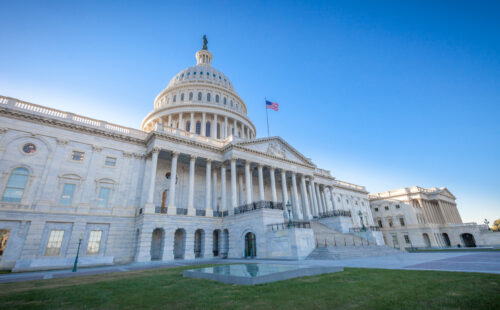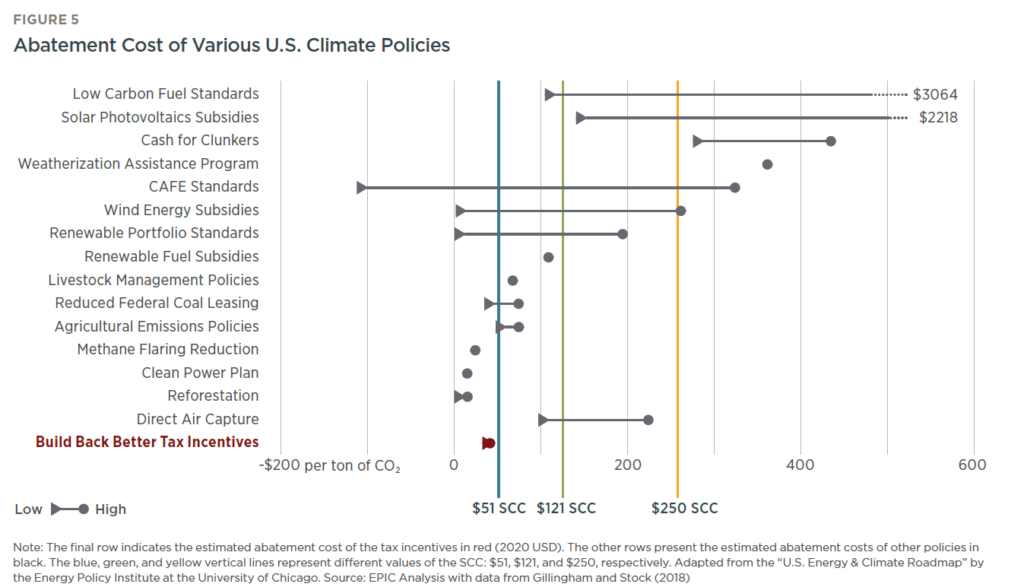Low angled view of the U.S. Capitol East Facade Front in Washington, DC.

If Washington Is Serious About US Competitiveness, It Needs to Go on Offense
If the 21st-century industrial contest were the upcoming NBA playoffs, you might say that China is the heavy favorite. Luckily, we don’t live in an elimination tournament, and have the tools at our disposal to make a comeback. In this moment when Covid outbreaks in China threaten our supply chains, and war in Ukraine our energy prices, it is critical that Congress first passes the financial incentives to accelerate the clean energy transition proposed in the Build Back Better reconciliation package followed by the Bipartisan Innovation Law (otherwise known as the America COMPETES Act).
Banning oil imports from Russia or slapping tariffs on Chinese-made solar panels won’t cut it. To dig out of a deep deficit, it’s not enough to lock in on defense and hope the other team’s shot stops falling — you have to get a few buckets of your own.
Fortunately, the United States has an elite roster.
Spurring Innovation
At point guard is America’s world-class innovation ecosystem, which brilliantly scans the court for technological opportunities. But to make the assist to US manufacturers, we need to invest in more than basic R&D. We need an inclusive approach that brings ideas from the research lab to the factory floor. The Bipartisan Innovation Law would strengthen public-private partnerships, including through the Manufacturing Extension Partnerships and Manufacturing USA institutes, establish a National Manufacturing Advisory Council, and equip the National Science Foundation to improve technology transfer in academia.
An especially important role here for the US federal government is helping fund and build the demonstration projects that take prototypes and prove their commercial viability. The Bipartisan Infrastructure Law took an important step in December last year by establishing a new Office of Clean Energy Demonstrations at the Department of Energy with over $20 billion of funding available for demonstration projects in areas like clean hydrogen, carbon capture, and small modular nuclear reactors. Further provisions in the Bipartisan Innovation Law would also help, including a $9.5 billion authorization to support the first three commercial-scale projects of transformative industrial technologies.
Lead by Example
Second, to create fastbreak opportunities, look to federal procurement. As a major buyer of vehicles and construction materials, the US government can leverage its immense purchasing power to jumpstart demand for clean technologies made in America. The Build Back Better Act included billions for procuring electric vehicles and low-carbon construction materials that Congress should advance. US manufacturers will be able to transition quickly, knowing there is a high-percentage basket at the other end. Federal buying power is particularly important in infrastructure, where Congress recently authorized $16 billion for the electricity grid, $7.5 billion for EV charging, and $2 billion of low-interest loans for CO2 pipeline construction.
Ramp Up Clean Energy Financial Incentives
Third, every championship team has a veteran presence. For years, tax credits have driven the deployment of clean electricity technologies like wind and solar. Congress should pass the expanded clean energy tax credits that were in the Build Back Better Act as an immediate priority, providing long-term incentives for solar and wind production, as well as the manufacturing of EVs, advanced batteries, green hydrogen, and carbon capture and sequestration (CCS). The stats speak for themselves: these tax credits alone could reduce electricity emissions by nearly 75 percent, and at an economic benefit to the American people of up to $1.8 trillion.
Take Advantage of our Regional Strengths
Fourth, a successful team needs specialists. Like a three-point sharpshooter waiting in the corner, the US industrial strategy should identify regional advantages. Specialized geographic clusters promote innovation, workforce development, and efficient supply chains. Some can build on existing industrial hubs, like electric vehicle production in the upper Midwest. The Make it In America Act includes $10 billion to create regional innovation centers that will benefit American communities gutted by the rise of Chinese industry. The Bipartisan Infrastructure Law’s $8 billion for hydrogen hubs and $4.5 billion for CCS hubs will also provide important anchors for regional development, built around these emerging sources of clean energy investment and job creation.
Invest, Invest, Invest
Fifth and finally, it’s time to call creative financing tools off the bench. Manufacturing is capital intensive, and government equity and debt instruments will be needed to rapidly build new facilities and retrofit existing ones. Ideally, a National Climate Bank, like the so-called “Greenhouse Gas Reduction Fund” proposed in the previous Build Back Better Act, will steer public dollars to critical security, energy, and climate priorities, but so too could Biden’s proposed changes to the Export-Import Bank.
In the clean energy sector, the Loan Programs Office (LPO) is the US’ most reliable bench player. During the Obama administration, the LPO helped commercialize the utility-scale solar PV industry, providing nearly $5 billion in loan guarantees for the first five utility-scale solar PV plants in the United States. The Build Back Better Act included provisions to boost funding for the LPO, such as a further $3 billion in loan authority for its Advanced Technology Vehicles Manufacturing Program and would have almost doubled its total commitment authority. Luckily, the Energy Act of 2020 already made some important changes at the LPO, adding two new categories of technologies it can invest in, as did the Bipartisan Infrastructure Law, which added critical minerals and heavy-duty vehicles, among other transport technologies, to its mandate.
In other words, we have the talent. What’s been missing is a game plan that turns our players into a team. The White House calls this a “21st-century American industrial strategy.”
To execute this team offense, Congress should pass the Bipartisan Innovation Law and key clean energy provisions in the reconciliation process in tandem, building upon the heavy lifting of the Bipartisan Infrastructure Law. This would send a strong market and geopolitical signal that autocrats’ stranglehold on America’s economy is coming to an end, that the clean energy sources driving American prosperity will be made in America, and that instability abroad need not derail opportunity at home.
One quarter into the 21st century, it’s time to get back on offense.
Read more: In 2021, President Biden approved historic bipartisan infrastructure funding. Now, Congress must finish the job with comprehensive clean energy incentives.

